We tested some of the best glove liners available today according to price, weight, warmth, and comfort. Read on to see how they performed, which is best for you, and get some valuable buying advice.
Table of Contents
Best Glove Liners
The best glove liners are:
- Best Overall Glove Liners for Warmth, Comfort, and Weight: ICEBREAKER Unisex Merino 200 Oasis Glove Liners
- Most Waterproof Glove Liners: OUTDOOR RESEARCH Versaliner Sensor Gloves
- Best Ultralight Glove Liners: NATHAN HyperNight Reflective Gloves
- Best Budget Glove Liners: DAKINE Rambler Liner Glove
- Best Glove Liners for Warmth: SMARTWOOL Merino 150 Glove
The product comparison table below is sortable. Click the arrow in the heading cell to sort the models by preferred spec.
| MODEL | PRICE | WEIGHT | MATERIAL | SCORE |
|---|---|---|---|---|
| 1. ICEBREAKER Unisex Merino 200 Oasis Glove Liners | $40 | 0.95 oz | Merino Wool, Spandex | 9/10 |
| 2. SMARTWOOL Merino 150 Glove | $30 | 2.47 oz | Merino Wool, Nylon | 8/10 |
| 3. OUTDOOR RESEARCH Versaliner Sensor Gloves | $60 | 2.8 oz | Nylon, Spandex, Polyester | 8/10 |
| 4. NATHAN HyperNight Reflective Gloves | $30 | 0.63 oz | Spandex, Polyester | 8/10 |
| 5. DAKINE Rambler Liner Glove | $20 | 2.8 - 3.2 oz | Polyester, Elastane, Polyamide | 8/10 |
| 6. TERRAMAR 1.0 Thermasilk Glove Liner | $25 | 0.64 oz | Filament Silk | 8/10 |
| 7. DAKINE Storm Liner Glove | $30 | 2.48 oz | Polyester, Elastane | 8/10 |
Best Overall Glove Liners
Icebreaker Unisex Merino 200 Oasis Glove Liners
Price: $40
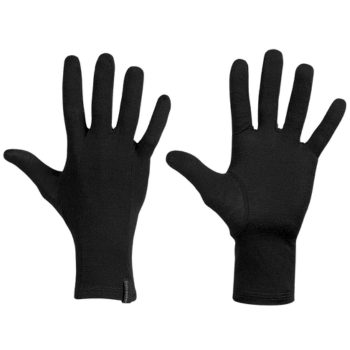
✅ Warm
✅ Comfy
✅ Ultralight
❌ On the expensive side
KEY SPECS
- Weight: 0.95 oz
- Material: Merino Wool, Spandex
The Icebreaker Oasis Merino Glove Liners impressed us with their balance of warmth, comfort, and weight. At just 0.95 ounces these are seriously lightweight, some of the lightest on our list. If you’re shopping for glove liners for warmth, Oasis gloves were plenty warm, especially when wearing a shell. Like the Smartwool 150, we think these are a great choice for standalone gloves in the fall and spring too.
What we love about merino wool is how comfortable and breathable it is. These gloves blend in 4% lycra fabric giving them enough stretch to stay dexterous all day long. We like that they have an ample cuff for wearing under a jacket too. At $40 these are the second most expensive on our list. Despite that, we vote the Icebreaker Oasis Merino 200 Glove Liners as our pick for best overall glove liners.
Best Glove Liners for Warmth
Smartwool Merino 150 Glove
Price: $30

✅ Warm
✅ Comfy
❌ Heavy
KEY SPECS
- Weight: 2.47 oz
- Material: Merino Wool, Nylon
If you want glove liners for warmth the Smartwool Merino 150 Gloves are one of the warmest on our list. This is thanks to being made from merino wool and the thicker overall wool layer. Although thicker than the thinnest option we tested, these are still thin. And the wool with a touch of nylon makes them a favorite of ours for comfort too.
We like these as standalone gloves for spring and fall hiking and an excellent option to keep your hands warm and toasty in winter when paired with a shell. At 2.47 ounces, these are on the heavier end of the products we tested. As a bonus, they have touch-sensitive areas on the forefinger and thumb, but like most touch-enabled gloves, they can be challenging to use.
Most Waterproof Glove Liners
Outdoor Research Versaliner Sensor Gloves
Price: $60
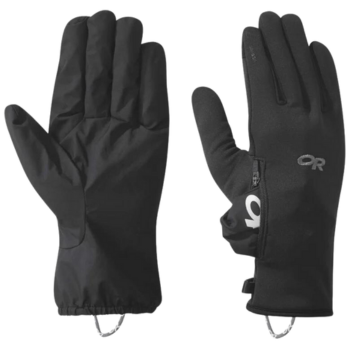
✅ Best weather-proof option
✅ Durable
✅ Warm
❌ Expensive
❌ Heavy
KEY SPECS
- Weight: 2.8 oz
- Material: Nylon, Spandex, Polyester
The Outdoor Research Versaliner Sensor Gloves are the most expensive gloves we tested, but don’t let the price deter you. Unlike most liners, the Versaliner Sensor gloves include both a polyester glove liner and a water and wind-resistant nylon shell that conveniently fits inside a pocket on the glove. This gives them the best weather resistance of all the gloves we tested. You can wear the liner alone while hiking and then throw on the shell when the wind or rain picks up.
We found the gloves to be durable, but the thin 20D nylon shell does need to be treated gently. The combo of the glove and shell makes these some of the warmest we tested, especially if wearing both under a larger glove. We like that the polyester glove has a slim fit that stretches to allow full motion of your hand. At 2.8 ounces they are quite heavy, straddling the line between glove liners and regular gloves.
Best Ultralight Glove Liners
Nathan HyperNight Reflective Gloves
Price: $30
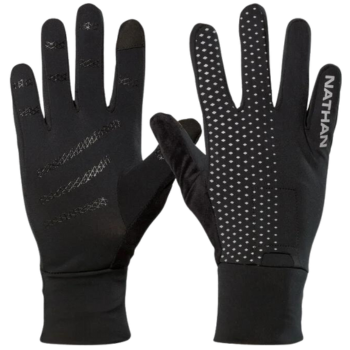
✅ Best ultralight glove liner
✅ Great for trail runners
✅ Comfy
❌ Less warm
KEY SPECS
- Weight: 0.63 oz
- Material: Spandex, Polyester
The Nathan HyperNight Reflective Gloves are our top choice for ultralight glove liners. At 0.63 ounces these are impossibly lightweight. Despite the weight, these are still feature-packed gloves. The reflective fabric is a great trail for running or hiking at night (or just to not lose them around camp). We found these to be the most comfortable synthetic gloves we tested thanks to the spandex and good breathability. The rubber grips on the thumbs help if you need to scramble over a rock or hand onto a water bottle. We also like the pocket on the glove for stashing a small car key.
These aren’t the warmest gloves we tested, but they work well as a standalone option if you want a touch of extra warmth in cool conditions. And paired with a glove liner they are more than adequate in winter conditions. We didn’t like that the stitching at the seams makes them feel bulkier than they should. The Nathan Reflective gloves are available in a men's and a women's version.
Best Budget Glove Liners
Dakine Rambler Liner Glove
Price: $20
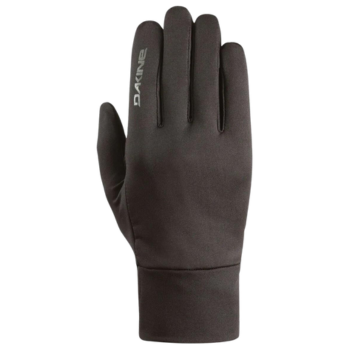
✅ Best budget option
✅ Durable
❌ Heavy
KEY SPECS
- Weight: 2.8 - 3.2 oz
- Material: Polyester, Elastane, Polyamide
The Dakine Rambler glove is a thin yet versatile glove that can be worn alone on cool spring days or with an outer glove during the fall and winter. The most notable feature for us is the price. At $20 this is the cheapest option on our list, making the Dakine Rambler our best budget glove liner. It has average warmth and can be worn standalone or paired with a shell.
We found the polyester fabric to be quick-drying and we like that the polyester fabric is sturdy enough to withstand daily hikes. The touchscreen-compatible fabric on the forefinger and thumb works well with a mobile phone or tablet. We like that there's even a handy clip that secures the two gloves together. Weight was our biggest complaint with these gloves. Pushing 3 ounces, these are the heaviest glove liners we tested.
The Other Noteworthy Models
Terramar 1.0 Thermasilk Glove Liner
Price: $25
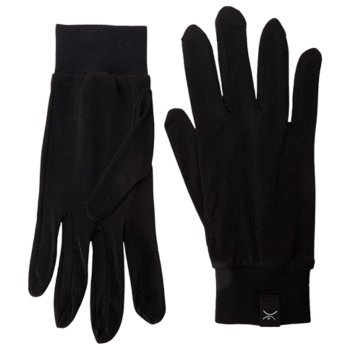
✅ Ultralight
✅ Inexpensive
✅ Comfy
❌ Less warm
❌ Less durable
❌ Less weather-resistant
KEY SPECS
- Weight: 0.64 oz
- Material: Filament Silk
If you want a very lightweight and thin layer to go inside a pair of gloves, the Terramar 1.0 Thermasilk Glove Liner is a top choice. We love that smooth silk gloves feel luxurious on your hand. Our only complaint in the comfort department is that a poorly placed tag at the cuff line is a bit annoying. The 0.64-ounce weight is one of the lightest we tested. Because they are silk, you need to be gentle with them, especially around velcro, which can snag the silk and tear the fabric. Silk is also less weather and water-resistant.
We found that these glove liners offer little wind protection. These are very thin gloves, which makes them the least warm glove we tested. We recommend pairing them with an outer shell to hold in heat. At $25 a pair, they are the second least expensive we tested making the Terramar 1.0 Termasilk a great budget option.
Dakine Storm Liner
Price: $30
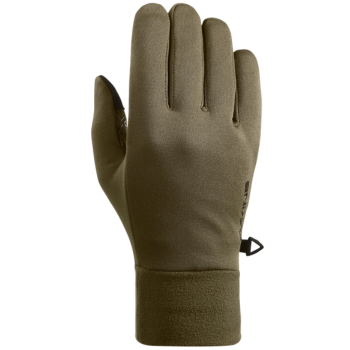
✅ Durable
✅ Good weather protection
❌ Heavy
KEY SPECS
- Weight: 2.48 oz
- Material: Polyester, Elastane
Made with stretchy fleece, the Dakine Storm Liner has a snug fit that moves as you bend and flex your hand. The fleece is soft against your skin and keeps your hands cozy and warm while you hike. We like that these synthetic gloves offer a good amount of wind and waterproofing when worn alone. And the thicker polyester fabric and rubber grips give these a good amount of durability too.
We found the wide touchscreen compatible forefinger and thumb area that works reliably. A solid interlocking clip keeps the gloves together when not in use and can be clipped to the outside of your pack. At 2.48 ounces these are one of the heavier options on our list.
Key Factors To Consider When Choosing
Price
Glove liners shouldn’t set you back too much, with the least expensive options being around $20. Premium glove liners can cost as much as $60 and are made with durable and weather-resistant materials. Expensive options can be overkill based on your needs. We recommend balancing price with the features that best suit your outdoor pursuits.
Glove liners that provide the greatest value:
- ICEBREAKER Unisex Merino 200 Oasis Glove Liners
- NATHAN HyperNight Reflective Gloves
- DAKINE Storm Liner Glove
Affordable glove liners:
Premium glove liners (most expensive):
Weight
Glove liners are a base layer and should be both light and packable. An ounce or two per pair provides sufficient warmth and coverage for your hands. We recommend nothing over 3 ounces.
The Lightest glove liners:
- NATHAN HyperNight Reflective Gloves
- TERRAMAR 1.0 Thermasilk Glove Liner
- ICEBREAKER Unisex Merino 200 Oasis Glove Liners
Comfort & Fit
Comfort is dependent on the material a glove liner is made from. We find merino wool and silk to be the most comfortable. For the best fit, we love merino wool with a little bit of synthetic blended-in to allow stretching as you move your hands. The most comfortable synthetic gloves have a thin fleece lining to give a soft feel while wearing. Later in this article, we’ll provide a full breakdown of the pros and cons of each material.
The most comfortable glove liners:
- ICEBREAKER Unisex Merino 200 Oasis Glove Liners
- SMARTWOOL Merino 150 Glove
- TERRAMAR 1.0 Thermasilk Glove Liner
Warmth
One of the most common reasons to wear glove liners is to provide additional warmth for your hands. Our tip is to think about glove liner warmth the same way you layer your clothing. In cool to mild winter conditions pair a thin glove liner with your outer gloves to add warmth while avoiding sweaty hands. In extreme winter conditions pair a thick glove liner with your outer gloves for maximum protection.
The warmest glove liners:
Other Things to Consider
Glove Liner Materials
MERINO
Merino wool is an excellent material for glove liners, especially in colder weather. Wool is naturally warm and holds in the heat even when wet. It also wicks sweat away from your hands, which is critical in cold weather. The last thing you want is a pair of gloves that will freeze because they are sopping wet with sweat. Merino wool dries relatively quickly when exposed to heat. It dries faster than cotton, but not as fast as synthetic or silk gloves.
SILK
Silk is known for its pleasant, smooth feel against your skin, but that's not the only redeeming quality found in this material. Silk is breathable and excels at wicking moisture away from your skin. It can absorb up to 30 percent of its weight and still feel dry to the touch. Silk also is fast drying. Your silk gloves will be warm, dry, and ready to wear after a few minutes in front of a campfire.
Soft silk glove liners feel lovely on your hands, but they do have a drawback. The silk material is very delicate. It can be damaged easily by rough surfaces and especially by velcro, which snags and tears the fabric.
SYNTHETIC
Synthetic gloves are a great choice when you don't need the warmth of wool but want something more rugged than silk. Artificial materials are breathable and fast drying like wool, but, unlike silk, they can take a beating. Some synthetic gloves are thin for dexterity, while others have a brushed fleece lining for added warmth.
OTHER MATERIALS
When shopping for glove liners, you may stumble across liners meant for driving, casual wearing around town, or working outside. The materials in these gloves are usually cotton, terry cloth, or nylon. They are not intended for hiking. They provide little to no warmth while wet, are not moisture-wicking, and don't dry as quickly as other materials.
 Merino wool glove liner on the left (Smartwool 150), synthetic on the right (OR Versaliner).
Merino wool glove liner on the left (Smartwool 150), synthetic on the right (OR Versaliner).
Breathability
Glove liners should be breathable, so your hands don't get sweaty while you hike. Breathability not only helps to keep your hands dry, but they also minimize chafing from moisture build-up.
Durability
Glove liners worn primarily under outer shell gloves can get away with being less durable. However, when doing activities like backcountry skiing, we love glove liners that are robust enough to wear on their own. Especially on uphill sections or when conditions warm up in the middle of the day.
Design
Most gloves have a similar size and shape but differ in the small design details. Some gloves have useful features like loops to help pull them on or secure clips to hold them together.
Cuff length also varies between gloves with some gloves extending over the wrist and onto the forearm. A longer cuff helps secure the glove on your hand, but not everyone likes the feeling of a long glove. Seams are another factor to consider. Look closely at the stitching to make sure they won't rub against a trekking pole or chafe your hands while climbing.
 A glove inside another glove? A great way to keep your shell gloves handy.
A glove inside another glove? A great way to keep your shell gloves handy.
Water Resistance
Water resistance is helpful but not essential for a glove liner. You can always throw on an outer glove if you need protection from rain or water. Look for glove liners that breathe well and dry quickly.
Sun Protection
Glove liners are versatile. Not only do they protect from the cold, but they also can block out the sun. This sun-blocking capability is especially important when hiking in the desert and similar areas that have high sun exposure. Choose lightweight, unlined gloves for summer use. The more they breathe, the better.
Touchscreen Compatibility
Many glove liners have touchscreen support that lets you interact with your cellphone or tablet device without removing your gloves. Look for a piece of touch-sensitive material on the fingertips of the glove. Your finger has to fit precisely into this touch-sensitive area for it to work correctly. It can be finicky, so practice with your gloves at home before you rely on them in the backcountry.
 Touchscreen pads on both the index finger and thumb (Dakine Rambler) make it easy to text.
Touchscreen pads on both the index finger and thumb (Dakine Rambler) make it easy to text.
Battery-Powered Heating
For frigid weather, some gloves use heated liners that are powered by rechargeable batteries. Because they need batteries for power, these gloves tend to be bulky and heavy. They also are hot, making them suitable for hunting, ice fishing, and similar low-intensity activities. They are not recommended for wearing while hiking unless you are going into extreme conditions.
Dexterity
The best glove liners are dexterous enough for you to operate a camera and other electronic equipment. If you need dexterity, we recommend choosing a glove liner with spandex or elastane which provides the most dexterity.
Are Glove Liners Worth It?
Yes, they are when you are in winter conditions where your hands are susceptible to frost bite. Frostbite happens faster and is more severe than you may realize. You can get frostbite on your fingers in as little as 30 minutes when the air temperature is 0° F. If you ignore the warning signs, you could lose a finger or two in the process.
Gloves keep your hands warm and agile, so you can use them to push or pull your way up a mountain. Like most clothing for hiking, it is best to use a layering system when choosing gloves for your hands. The base layer typically is a glove liner that slips inside an outer waterproof, windproof, or insulated shell. Liners tend to be lightweight and packable, so there is no reason why they shouldn't have a place in your pack.






 650-Calorie Fuel
650-Calorie Fuel



